Italian Brazilians
Italian Brazilians (Italian: italo-brasiliani, Portuguese: ítalo-brasileiros) are Brazilian citizens of full or partial Italian descent.[5] Italian Brazilians are the largest number of people with full or partial Italian ancestry outside Italy, with São Paulo being the most populous city with Italian ancestry in the world. Nowadays, it is possible to find millions of descendants of Italians, from the southeastern state of Minas Gerais to the southernmost state of Rio Grande do Sul, with the majority living in São Paulo state[6] and the highest percentage in the southeastern state of Espírito Santo (60-75%).[7][8] Small southern Brazilian towns, such as Nova Veneza, have as much as 95% of their population of Italian descent.[9]
| Total population | |
|---|---|
| No official statistics; est. 32 million descendants (15% of the population, according to Pertile and the Embassy)[1][2][3] 447,067 (2019 Italian citizens)[4] | |
| Regions with significant populations | |
| Mainly São Paulo, Southern and Espirito Santo. Some immigration to Rio de Janeiro. | |
| Languages | |
| Predominantly Portuguese. Minority Talian dialect and Italian and/or various Italian languages. | |
| Religion | |
| |
| Related ethnic groups | |
| Other Italians · Catholic and Latins, Romance-speaking European Brazilians such as Portuguese Brazilians, Spanish Brazilians, French Brazilians, Greek Brazilians, Swiss Brazilians, German Brazilians, Austrian Brazilians, and Brazilian immigrants in Italy |
There are no official numbers of how many Brazilians have Italian ancestry, as the national census conducted by IBGE does not ask the ancestry of the Brazilian people. In 1940, the last census to ask ancestry, 1,260,931 Brazilians were said to be the child of an Italian father, and 1,069,862 said to be the child of an Italian mother. Italians were 285,000 and naturalized Brazilians 40,000. Therefore, Italians and their children were, at most, just over 3.8% of Brazil's population in 1940.[10]
A 1999 survey, conducted by the sociologist and former president of the Brazilian Institute of Geography and Statistics (IBGE), Simon Schwartzman, indicated that 10.5% of Brazilian respondents claimed to have Italian ancestry; hence they would make up around 20 million descendants in a national population of 200 million.[11] An Italian source, from 1996, cites the number of 22,753,000 descendants.[12] The Embassy of Italy in Brazil, in 2013, reported the number of 31 million descendants of Italian immigrants in Brazil (about 15% of the population), half of them in the state of São Paulo.[2] Brazilian culture has significant connections to Italian culture in terms of language, customs, and traditions. Brazil is also a strongly Italophilic country as cuisine, fashion and lifestyle has been sharply influenced by Italian immigration.
Italian immigration to Brazil
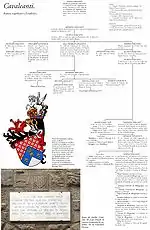
According to the Italian government, there are 31 million Brazilians of Italian descent,[15] All figures relate to Brazilians of any Italian descent, not necessarily linked to Italian culture in any significant way. According to García,[16] the number of Brazilians with actual links to Italian identity and culture would be around 3.5 to 4.5 million people. Scholar Luigi Favero, in a book on Italian emigration between 1876 and 1976, pinpointed that Italians were present in Brasil since the Renaissance: Genoese sailors and merchants were between the first to settle in colonial Brazil since the first half of the 16th century,[17] and so, because of the many descendants of Italians emigrated there from Columbus times until 1860, the number of Brazilians with Italian roots should be increased to 35 million.[18]
Although they were victims of some prejudice in the first decades and in spite of the persecution during World War II, Brazilians of Italian descent managed to integrate and assimilate seamlessly into the Brazilian society.
Many Brazilian politicians, artists, footballers, models, and personalities are or were of Italian descent. Italian-Brazilians have been state governors, representatives, mayors and ambassadors. Four Presidents of Brazil were of Italian descent (but none of the first three directly elected to such a position): Pascoal Ranieri Mazzilli (Senate president who served as interim president), Itamar Franco (elected vice-President under Fernando Collor, whom he eventually replaced as the latter was impeached), Emílio Garrastazu Médici (third of the series of generals who presided over Brazil during the military regime, also of Basque descent) and Jair Messias Bolsonaro (elected in 2018).
Citizenship
According to the Brazilian Constitution, anyone born in the country is a Brazilian citizen by birthright. In addition, many born in Italy have become naturalized citizens after they settled in Brazil. The Brazilian government used to prohibit multiple citizenship. However, that changed in 1994 by a new constitutional amendment.[19] After the changes, over half a million Italian-Brazilians have requested recognition of their Italian citizenship.[20]
According to Italian legislation, an individual with an Italian parent is automatically recognized as an Italian citizen. To exercise the rights and obligations of citizenship, individual must have all documents registered in Italy, which normally involves the local consulate or embassy. Some limitations are applied to the process of recognition such as the renouncement of the Italian citizenship by the individual or the parent (if before the child's birth), a second limitation is that women transferred citizenship to their children only after 1948.[21] After a constitutional reform in Italy, Italian citizens abroad may elect representatives to the Italian Chamber of Deputies and the Italian Senate. Italian citizens residing in Brazil elect representatives together with Argentina, Uruguay and other countries in South America. According to Italian Senator Edoardo Pollastri, over half-a-million Brazilians are waiting to have their Italian citizenship recognized.[20]

Italian crisis in late 19th century
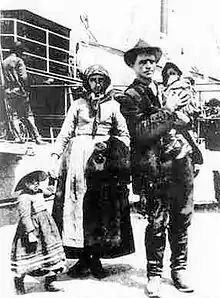
Italy did not become a sovereign national state until 1861. Before then, Italy was politically divided in several kingdoms, ducates, and other small states. That fact influenced deeply the character of the Italian migrant: "Before 1914, the typical Italian migrant was a man without a clear national identity but with strong attachments to his town or village or region of birth, to which half of all migrants returned."[22]
In the 19th century, many Italians fled the political persecutions in Italy led by the Imperial Austrian government after the failure of unification movements in 1848 and 1861. Although very small, the well-educated and revolutionary group of emigrants left a deep mark where they settled.[23] In Brazil, the most famous Italian was then Líbero Badaró. However, the mass Italian immigration that contributed to shape Brazilian culture after the Portuguese and the German migration movements started only after Italian unification.
During the last quarter of the 19th century, the newly united Italy suffered an economic crisis. Northern Italy had unemployment because of the introduction of new techniques in agriculture, and Southern Italy remained underdeveloped and almost untouched by modernization in agrarian structure. Even in the North, industrialization was still in its initial stages, and illiteracy was still common (but that was even more true in the South).[24] Thus, poverty and lack of jobs and income stimulated Northern (and Southern) Italians to emigrate. Most Italian immigrants were very poor rural workers (braccianti).[25]
Brazilian need of immigrants
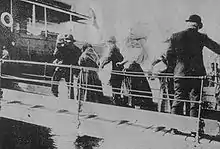
In 1850, under British pressure, Brazil finally passed a law that effectively banned transatlantic slave trade. The increased pressure of the abolitionist movement, on the other hand, made it clear that the days of slavery in Brazil were coming to an end. Slave trade was effectively suppressed, but the slave system still endured for almost four decades. Thus, discussion on European immigration to Brazil became a priority for Brazilian landowners, who claimed that such migrants were or would soon become indispensable for Brazilian agriculture. They would soon win the argument, and mass migration would begin in earnest.
An Agriculture Congress in 1878 in Rio de Janeiro discussed the lack of labor and proposed to the government the stimulation of European immigration to Brazil. Immigrants from Italy, Portugal, and Spain were considered the best ones because they were white and mainly Catholic. Therefore, the Brazilian government started to attract more Italian immigrants to the coffee plantations.

At the end of the 19th century, the Brazilian government was influenced by eugenics theories. According to some Brazilian scholars, immigrants from Europe were needed to enhance the Brazilian population.
Beginning of Italian settlement in Brazil
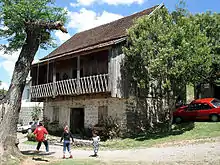
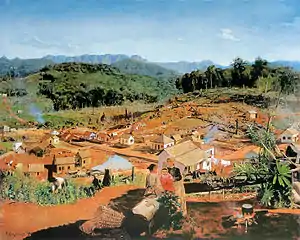
The Brazilian government, with or following the Emperor's support, had created the first colonies of immigrants (colônias de imigrantes) in the early 19th century. The colonies were established in rural areas of the country, being settled by European families, mainly German immigrants who settled in many areas of Southern Brazil.
The first groups of Italians arrived in 1875, but the boom of Italian immigration in Brazil happened between 1880 and 1900, when almost one million Italians arrived.
Many Italians was naturalized Brazilian at the end of the 19th century, when the 'Great Naturalization' conceded automatically citizenship to all the immigrants residing in Brazil prior to 15 November 1889 "unless they declared a desire to keep their original nationality within six months."[26]
During the end of the 19th century, denouncement of bad conditions in Brazil increased in the press. Reacting to the public clamor and many proved cases of mistreatment of Italian immigrants, the government of Italy issued in 1902 the Prinetti Decree forbidding subsidized immigration to Brazil. In consequence, the number of Italian immigrants in Brazil fell drastically in the beginning of the 20th century, but the wave of Italian immigration continued until 1920.[27]
Over half of the Italian immigrants came from northern Italian regions of Veneto, Lombardy and Emilia-Romagna, and from the central Italian region of Tuscany. About 30% emigrated from Veneto.[24] On the other hand, in the 20th century, southern Italians predominated in Brazil, coming from the regions of Campania, Abruzzo, Molise, Basilicata and Sicily.
Prince Umberto's visit in 1924
In 1924, Umberto, Prince of Piedmont (the future King Umberto II of Italy) came to Brazil as part of a state visit to various South American countries. That was part of the political plan of the new fascist government to link Italian people living outside of Italy with their mother country and the interests of the regime. The visit was disrupted considerably by the ongoing Tenente revolts, which made it impossible for Umberto to reach Rio de Janeiro and São Paulo. Nevertheless, he was hosted at Bahia, where members of the Italian colony in the city were very happy and proud about his visit, thus achieving some of the visit's purposes.
Statistics
1940 Brazilian census
The Brazilian census of 1940 asked Brazilians where their fathers came from. It revealed that at that time there were 3,275,732 Brazilians who were born to an immigrant father. Of those, 1,260,931 Brazilians were born to an Italian father. Italian was the main reported paternal immigrant origin, followed by Portuguese with 735,929 children, Spanish with 340,479 and German with 159,809 children.[28]
The census also revealed that the 458,281 foreign mothers of 12 or more years who lived in Brazil had 2,852,427 children, of whom 2,657,974 were born alive. Italian women had more children than any other female immigrant community in Brazil: 1,069,862 Brazilians were born to an Italian mother, followed by 524,940 who were born to a Portuguese mother, 436,305 to a Spanish mother and 171,790 to a Japanese mother.[28] The 6,809,772 Brazilian-born mothers of 12 or more years had 38,716,508 children, of whom 35,777,402 were born alive.
| Brazilians who were born to a foreign-born father (1940 Census)[28] | |||||
|---|---|---|---|---|---|
| Main place of birth of the father | Number of children | ||||
| Italy | 1,260,931 | ||||
| Portugal | 735,929 | ||||
| Spain | 340,479 | ||||
| Germany | 159,809 | ||||
| Syria- Lebanon- Palestine- Iraq - Middle-Eastern | 107,074 | ||||
| Japan-Korea | 104,355 | ||||
| Women over 12 years old who had offspring in Brazil and their children, by country of birth (1940 Census)[28] | |||||
|---|---|---|---|---|---|
| Country of birth of the mother | Number of females over 12 years old who had children |
Number of children | |||
| Italy | 130,273 | 1,069,862 | |||
| Portugal | 99,197 | 524,940 | |||
| Spain | 66,354 | 436,305 | |||
| Japan | 35,640 | 171,790 | |||
| Germany | 22,232 | 98,653 | |||
| Brazil | 6,809,772 | 38,716,508 | |||
Others
On the other hand, in 1998, the IBGE, within its preparation for the 2000 Census, experimentally introduced a question about "origem" (ancestry) in its "Pesquisa Mensal de Emprego" (Monthly Employment Research) to test the viability of introducing that variable in the census[29] (the IBGE ended by deciding against the inclusion of questions about it in the Census). The research interviewed about 90,000 people in six metropolitan regions (São Paulo, Rio de Janeiro, Porto Alegre, Belo Horizonte, Salvador, and Recife).[29]
The results of the survey contradict the claims of the Italian embassy to Brazil. While the latter claims that Italian Brazilians are up to 18% of the Brazilian population, with absolute figures varying between 28 and 31 million, and figures for the city of São Paulo as high as 60% or 6 million, the IBGE found actually a figure of 10%, which would then correspond to a total population of about 3.5 million people of Italian origin in the whole set of metropolitan regions that it researched, including São Paulo (and Porto Alegre, another metropolitan region with a high concentration of oriundi).
| Arrival of Italian immigrants to Brazil by periods (source: IBGE)[27] | |||||||||
|---|---|---|---|---|---|---|---|---|---|
| 1884-1893 | 1894–1903 | 1904–1913 | 1914–1923 | 1924–1933 | 1934–1944 | 1945–1949 | 1950–1954 | 1955–1959 | |
| 510,533 | 537,784 | 196,521 | 86,320 | 70,177 | 15,312 | N/A | 59,785 | 31,263 | |
| Italian population in Brazil[30] | |||||
|---|---|---|---|---|---|
| Year | Estimated Italian population (by Giorgio Mortara) | Year | Italian estimates | Year | Brazilian Census |
| 1880 | 50,000 | 1881* | 82,000 | ||
| 1890 | 230,000 | 1891* | 554,000 | ||
| 1900 | 540,000 | 1901** | 1,300,000 | ||
| 1902 | 600,000 | 1904** | 1,100,000 | ||
| 1930 | 435,000 | 1927* | 1,837,887 | 1920 | 558,405 |
| 1940 | 325,000 | 1940 | 325,283 | ||
.* Comissariato Generale dell'Emigrazione
.** Consulates
The 1920 census was the first one to show a more specific figure about the size of the Italian population in Brazil (558,405). However, since the 20th century, the arrival of new Italian immigrants to Brazil has been in steady decline. The previous censuses of 1890 and 1900 had limited information. In consequence, there are no official figures about the size of the Italian population in Brazil during the mass immigration period (1880–1900). There are estimates available, and the most reliable was done by Giorgio Mortara even though his figures may have underestimated the real size of the Italian population.[31] On the other hand, Angelo Trento believes that the Italian estimates are "certainly exaggerated"[31] and "lacking of any foundation"[31] since they found a figure of 1,837,887 Italians in Brazil for 1927. Another evaluation conducted by Bruno Zuculin found 997,887 Italians in Brazil in 1927. All of those figures include only people born in Italy, not their Brazilian-born descendants.[30]
| Brazilians of Italian descent by states or regions as of 2000 estimatives[32] | |||||||||
|---|---|---|---|---|---|---|---|---|---|
| Region | State | Total population (millions) | Italian Brazilians | ||||||
| Population (millions) | Percentage | ||||||||
| Southeastern | São Paulo | 33.1 | 9.9 | 29.9% | |||||
| Espírito Santo | 2.6 | 1.7 | 65.4% | ||||||
| Minas Gerais | 15.8 | 1.3 | 8.2% | ||||||
| Rio de Janeiro | 14.1 | 0.60 | 4.3% | ||||||
| Southern | Paraná | 9.4 | 3.7 | 39.4% | |||||
| Rio Grande do Sul | 9.5 | 2.1 | 22.1% | ||||||
| Santa Catarina | 4.5 | 2.7 | 60.0% | ||||||
| Northern Brazil | All | 8.9 | 1.0 | 11.2% | |||||
| Central-western | All | 10.4 | 0.40 | 3.8% | |||||
| Northeastern | All | 42.8 | 0.15 | 0.4% | |||||
| Total in Brazil | 151.1 | 23.6 | 15.6% | ||||||
Main Italian settlements in Brazil
Areas of settlement
Among all Italians who immigrated to Brazil, 70% went to the State of São Paulo. In consequence, São Paulo has more people with Italian ancestry than any region of Italy itself.[33] The rest went mostly to the states of Rio Grande do Sul and Minas Gerais.
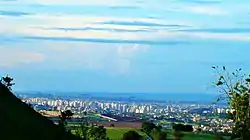
Internal migration made many second- and third-generation Italians move to other areas. In the early 20th century, many rural Italian workers from Rio Grande do Sul migrated to the west of Santa Catarina and then farther north to Paraná.
More recently, third- and fourth-generation Italians have migrated to other areas and so people of Italian descent can be found in Brazilian regions in which the immigrants had never settled, such as in the Cerrado region of Central-West, in the Northeast and in the Amazon rainforest area, in the extreme North of Brazil.[35][36]
| Farms owned by a foreigner (1920) | |||
|---|---|---|---|
| Immigrants | Farms[37] | ||
| Italians | 35.984 | ||
| Portuguese | 9.552 | ||
| Germans | 6.887 | ||
| Spanish | 4.725 | ||
| Russians | 4.471 | ||
| Austrians | 4.292 | ||
| Japanese | 1.167 | ||
Southern Brazil
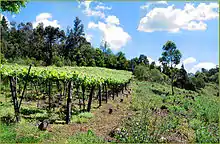

The main areas of Italian settlement in Brazil were the Southern and Southeastern Regions, namely the states of São Paulo, Rio Grande do Sul, Santa Catarina, Paraná, Espírito Santo and Minas Gerais.
The first colonies to be populated by Italians were created in the highlands of Rio Grande do Sul (Serra Gaúcha). They were Garibaldi and Bento Gonçalves. The immigrants were predominantly from Veneto, in northern Italy. After five years, in 1880, the great numbers of Italian immigrants arriving caused the Brazilian government to create another Italian colony, Caxias do Sul. After initially settling in the government-promoted colonies, many Italian immigrants spread into other areas of Rio Grande do Sul, seeking better opportunities, and created many other Italian colonies on their own, mainly in highlands, because the lowlands were already populated by German immigrants and native gaúchos.
Italians established many vineyards in the region. The wine produced in those areas of Italian colonization in southern Brazil is much appreciated within the country, but little is available for export. In 1875, the first Italian colonies were established in Santa Catarina, which lies immediately to the north of Rio Grande do Sul. The colonies gave rise to towns such as Criciúma, and later also spread further north, to Paraná.
In the colonies of southern Brazil, Italian immigrants at first stuck to themselves, where they could speak their native Italian dialects and keep their culture and traditions. With time, however, they would become thoroughly integrated economically and culturally into the larger society. In any case, Italian immigration to southern Brazil was very important to the economic development and the culture of the region.
Southeastern Brazil
Pietro Belli, Italian journalist in São Paulo (1925)[38]

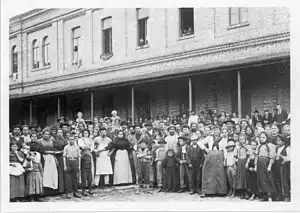
Some of the immigrants settled in the colonies in Southern Brazil. However, most of them settled in Southeastern Brazil (mainly in the State of São Paulo). At first, the government was responsible for bringing the immigrants (in most cases, paying for their transportation by ship), but later, the farmers were responsible for making contracts with immigrants or specialized companies in recruiting Italian workers. Many posters were spread in Italy, with pictures of Brazil, selling the idea that everybody could become rich there by working with coffee, which was called by the Italian immigrants the green gold. Most coffee plantations were in the States of São Paulo and Minas Gerais, and in a smaller proportion also in the States of Espírito Santo and Rio de Janeiro.
Rio de Janeiro was declining in the 19th century as a farming producer, and São Paulo had already taken the lead as a coffee producer/exporter in the early 20th century, as well as big producer of sugar and other important crops. Thus, migrants were naturally more attracted to the State of São Paulo and the southern states.
Italians migrated to Brazil as families.[39] The colono, as a rural immigrant was called, had to sign a contract with the farmer to work in the coffee plantation for a minimum period of time. However, the situation was not easy. Many Brazilian farmers were used to command slaves and treated the immigrants as indentured servants.
In Southern Brazil, the Italian immigrants were living in relatively well-developed colonies, but in Southeastern Brazil they were living in semislavery conditions in the coffee plantations. Many rebellions against Brazilian farmers occurred, and public denouncements caused great commotion in Italy, forcing the Italian government to issue the Prinetti Decree, which established barriers to immigration to Brazil.
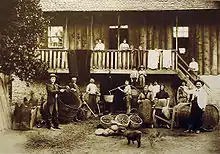
| Year | Italians | Percentage of the city[30] |
|---|---|---|
| 1886 | 5,717 | 13% |
| 1893 | 45,457 | 35% |
| 1900 | 75,000 | 31% |
| 1910 | 130,000 | 33% |
| 1916 | 187,540 | 37% |
In 1901, 90% of industrial workers and 80% of construction workers in São Paulo were Italians.[40]
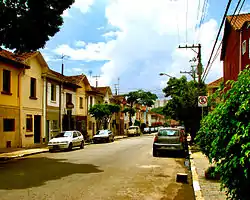
| Year | Italians | Percentage of the city |
|---|---|---|
| 1886 | 1,050 | 6,5%[42] |
| 1920 | 8,235 | 15%[43] |
| 1934 | 4,185 | 8,1%[44] |
| 1940 | 2,467 | 5%[45] |
| Year | Italians | Percentage of the city |
|---|---|---|
| 1886 | 158 | 1,5%[42] |
| 1920 | 10,907 | 16%[46] |
| 1934 | 6,211 | 7,6%[47] |
| 1940 | 3,777 | 4,7%[48] |
São Carlos and Ribeirão Preto were two of the main coffee plantation centers. Both were respectively in the North-Central and Northeastern regions of São Paulo state, a zone known by its hot temperature and a fertile soil in which some of the richest coffee farms were and attracted most immigrants arriving in São Paulo, including Italians, between 1901 and 1940.[49]
| Year | Italians[30] |
|---|---|
| 1895 | 20,000 |
| 1901 | 30,000 |
| 1910 | 35,000 |
| 1920 | 31,929 |
| 1940 | 22,768 |
Other parts of Brazil
Although most Brazilians of Italian descent live in the South and Southeast part of the country, in recent decades (1960s-present), people from southern Brazil, mainly of Italian descent, have played a vital role in settling and developing the vast "cerrado" grasslands of Central-West, North and the west part of Northeastern Brazil.
Those areas, once economically neglected, are fast becoming one of the world's most important agricultural regions. The cerrado (Portuguese for thick and dense, meaning thick grassland) is a vast area of savanna-like grasslands in Brazil. In the State of Mato Grosso do Sul, Italian descendants are 5% of the population.[50]
Decline of Italian immigration
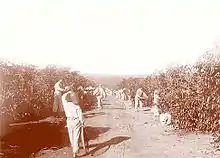
In 1902, the Italian immigration to Brazil started to decline. From 1903 to 1920, only 306,652 Italians immigrated to Brazil, compared to 953,453 to Argentina and 3,581,322 to the United States. This was mainly due to the Prinetti Decree in Italy, banning subsidized immigration to Brazil and so the Brazilian government or landowners could no longer pay the immigrants' passage). The Prinetti Decree was issued because of the commotion in the Italian press about the poverty faced by most Italians in Brazil.
Immigrants who went to Southern Brazil became small landowners and, despite the problems that they faced (dense forest, epidemics of yellow fever, lack of consumer market), the easy access to lands increased their opportunities. However, only a few Italians were taken to Southern Brazil. Most of the country's economy was based on coffee plantations, and Brazil was already the main coffee exporter in the world (since the 1850s). The end of slavery made most former slaves left the plantations and so there was a labour shortage on coffee plantations. Moreover, "natural inequality of human beings", "hierarchy of races", Social Darwinism, Positivism and other theories were used to explain that the European workers were superior to the native workers. In consequence, passages were offered to Europeans (the so-called "subsidized immigration"), mostly to Italians, so that they could come to Brazil and work on the plantations.[30]
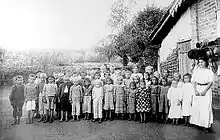
Those immigrants were employed in enormous latifundia (large-scale farms), formerly employing slaves. In Brazil, there were no labour laws (the first concrete labour laws appeared only in the 1930s, under President Getúlio Vargas) and so workers had almost no legal protection. Contracts signed by the immigrants could easily be violated by the Brazilian landowners who were accustomed to dealing with African slaves.
The remnants of slavery influenced on how Brazilian landowners dealt with Italian workers: immigrants were often monitored, with extensive hours of work. In some cases, they were obliged to buy products that they needed from the landowner. Moreover, the coffee farms were located in rather isolated regions. If the immigrants became sick, they would take hours to reach the nearest hospital.
The structure of labor used on farms included the labor of Italian women and children. Keeping their Italian culture was also made more difficult: the Catholic churches and Italian cultural centers were far from farms. The immigrants who did not accept the standards imposed by landowners were replaced by other immigrants. That forced them to accept the impositions of landowners, or they would have to leave their lands. Even though Italians were considered to be "superior" to blacks by Brazilian landowners, the situation faced by Italians in Brazil was so similar to that of the slaves that farmers called them escravos brancos (white slaves in Portuguese).[30]
The destitution faced by Italians and other immigrants in Brazil caused great commotion in the Italian press, which culminated in the Prinetti Decree in 1902. Many immigrants left Brazil after their experience on São Paulo's coffee farms. Between 1882 and 1914, 1.5 million immigrants of different nationalities came to São Paulo, and 695,000 left the state, or 45% of the total. The high numbers of Italians asking the Italian consulate a passage to leave Brazil was so significant that in 1907, most Italian funds for repatriation were used in Brazil. It is estimated that, between 1890 and 1904, 223,031 (14,869 annually) Italians left Brazil, mainly after failed experiences on coffee farms. Most of the Italians who left the country were unable to add the money they wanted. Most returned to Italy, but others remigrated to Argentina, Uruguay or to the United States.
The output of immigrants concerned Brazilian landowners, who constantly complained about the lack of workers. Spanish immigrants began arriving in greater numbers, but soon, Spain also started to create barriers for further immigration of Spaniards to coffee farms in Brazil. The continuing problem of lack of labor in the farms was, then, temporarily resolved with the arrival of Japanese immigrants, from 1908.[30]
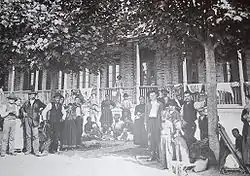
Despite the high numbers of immigrants leaving the country, most Italians remained in Brazil. Most of the immigrants remained only one year working on coffee farms and then left the plantations. A few earned enough money to buy their own lands and became farmers themselves. However, most migrated to Brazilian cities. Many Italians worked in factories (in 1901, 81% of the São Paulo's factory workers were Italians). In Rio de Janeiro, many the factory workers were Italians. In São Paulo, those workers established themselves in the center of the city, living in cortiços (degraded multifamily row houses). The agglomerations of Italians in cities gave birth to typically Italian neighborhoods, such as Mooca, which is until today linked to its Italian past. Other Italians became traders, mostly itinerant traders, selling their products in different regions.
A common presence on the streets of São Paulo were the Italian boys working as newspaper boys, as an Italian traveler observed: "In the crowd, we can see many Italian boys, shabby and barefoot, selling the newspapers from the city and from Rio de Janeiro, bothering the passersby with their offerings and their shouting of street roguish."[30]
Despite the poverty and even semi-slavery conditions faced by many Italians in Brazil, most of the population achieved some personal success and changed their lower-class situation. Even though most of the first generation of immigrants still lived in poverty, their children, born in Brazil, often changed their social status as they diversified their field of work, leaving the poor conditions of their parents and often becoming part of the local elite.[30]
Assimilation
Except for some isolated cases of violence between Brazilians and Italians, especially between 1892 and 1896, integration in Brazil was quick and peaceful. For Italians in São Paulo, scholars suggest that assimilation occurred within two generations. Research suggests that even first-generation immigrants born in Italy soon became assimilated in the new country. Even in Southern Brazil, where most of the Italians were living in isolated rural communities, with little contact with Brazilians, which kept the Italian patriarchal family structure, and therefore the father chose the wife or husband for their children, giving preference to Italians, assimilation was also quick.[30]
According to the 1940 census in Rio Grande do Sul, 393,934 people reported to speak German as their first language (11.86% of the state's population). In comparison, 295,995 reported to speak Italian, mostly dialects (8.91% of the state's population). Even though Italian immigration was larger and more recent than German immigrationn, the Italian group tended to be more easily assimilated. In the 1950 Census, the number of people in Rio Grande do Sul who reported to speak Italian dropped to 190,376.
In São Paulo, where more Italians settled, in the 1940 census 28,910 Italian-born people reported to speak Italian at home (only 13.6% of the state's Italian population). In comparison, 49.1% of the immigrants of other nationalities reported to keep speaking their native languages at home (with the exception of the Portuguese, of course). Then, the prohibition of speaking Italian, German, and Japanese during World War II was not so serious to the Italian community as it was to the other two groups.[30]
A major measure of the government occurred in 1889, when Brazilian citizenship was granted to all immigrants, but the act had little influence on their identity or assimilation process. Both the Italian newspapers in Brazil and the Italian government were uncomfortable with the assimilation of Italians in the country, which occurred mostly after the Great Naturalization period. Italian institutions encouraged the entry of Italians in Brazilian politics, but the presence of immigrants was initially small. Italian dialects came to dominate the streets of São Paulo and in some Southern localities. Over time, languages based on Italian dialects tended to disappear, and their presence is now small.[30]
At first, especially in rural Southern Brazil, Italians tended to marry only other Italians. On the other hand, Italians in São Paulo and other cities, tended to marry Brazilians. Over time and with the decrease of more immigrants arriving, even in Southern Brazil they started to integrate themselves with Brazilians. About Italians in Santa Catarina, the Italian consul asserted:
The marriage between an Italian man and a Brazilian woman, between an Italian woman and a Brazilian man is very common, and it would be even more frequent if the majority of the Italians were not living segregated on the countryside.[30]
There is little information about this trend, but it was noticed a large process of integration since World War I. Between 1917 and 1923, in Rio Grande do Sul: weddings between an Italian man and a Brazilian woman (997, 66.1%); Italian woman and Brazilian man (135, 9%) and Italian man and Italian woman (375, 24.9%).
Marriages between Italians and Brazilians were extremely common, mostly in the low classes, and were largely accepted for both people. However, some more closed members of the Italian community saw this integration process as negative. Brazilian Indians were often treated as wild people, and conflicts between Italians and Indians for the occupation of lands in Southern Brazil were common.[30]
Prosperity

Historically, Italians have been divided into two groups in Brazil. Those in Southern Brazil lived in rural colonies in contact with mostly other people of Italian descent. However, those in Southeast Brazil, the most populated region of the country, integrated into Brazilian society quite quickly.
After some years working in coffee plantations, some immigrants earned enough money to buy their own land and become farmers themselves. Others left the rural areas and moved to cities, mainly São Paulo, Campinas, São Carlos and Ribeirão Preto. A very few became very rich in the process and attracted more Italian immigrants. In the early 20th century, São Paulo became known as the City of the Italians, because 31% of its inhabitants were of Italian nationality in 1900.[51] The city of São Paulo had the second-highest population of people with Italian ancestry in the world at this time, after only Rome.[33] In Campinas, street signs in Italian were common,[52] a large commercial and services sector owned by Italian Brazilians developed, and more than 60% of the population had Italian surnames.[53] Today, nearly 30% of the population of Belo Horizonte remains of Italian ancestry.[54]
Italian immigrants were very important to the development of many big cities in Brazil, such as São Paulo, Porto Alegre, Curitiba and Belo Horizonte. Bad conditions in rural areas made thousands of Italians move there. Most of them became laborers and participated actively in the industrialization of Brazil in the early 20th century. Others became investors, bankers and industrialists, such as Count Matarazzo, whose family became the richest industrialists in São Paulo byholding of more than 200 industries and businesses. In Rio Grande do Sul, 42% of the industrial companies have Italians roots.[35]
Italians and their descendants were also quick to organize themselves and establish mutual aid societies (such as the Circolo Italiano), hospitals, schools (such as the Istituto Colégio Dante Alighieri, in São Paulo), labor unions, newspapers as Il Piccolo from Mooca and Fanfulla (for the whole city of São Paulo), magazines, radio stations and association football teams such as: Clube Atlético Votorantim, the old Sport Club Savóia from Sorocaba, Clube Atlético Juventus of Italians Brazilians from Mooca (old worker quarter from city of São Paulo) and the great clubs (which had the same name) Palestra Italia, later renamed to Sociedade Esportiva Palmeiras in São Paulo and Cruzeiro Esporte Clube in Belo Horizonte.

| Industries | |||
|---|---|---|---|
| 1907 | 1920 | ||
| Brazil[55] | 2.258 | 13.336 | |
| Owned by Italians[30] | 398 (17,6%) | 2.119 (15,9%) | |
| Owners of 204 largest industries in São Paulo (1962)[56] | |||
|---|---|---|---|
| Generation | Percentage | ||
| Immigrant | 49,5% | ||
| Son of an immigrant | 23,5% | ||
| Brazilian (more than 3 generations) | 15,7% | ||
| Grandson of an immigrant | 11,3% | ||
| Ethnic origin | Percentage | ||
| Italians | 34,8% | ||
| Brazilians | 15,7% | ||
| Portuguese | 11,7% | ||
| Germans | 10,3% | ||
| Syrians and Lebanese | 9,0% | ||
| Russians | 2,9% | ||
| Austrians | 2,4% | ||
| Swiss | 2,4% | ||
| Other Europeans | 9,1% | ||
| Others | 2,0% | ||
| Industries owned by an Italian[30] | |||
|---|---|---|---|
| State | 1907 | 1920 | |
| São Paulo | 120 | 1,446 | |
| Minas Gerais | 111 | 149 | |
| Rio Grande do Sul | 50 | 227 | |
| Rio de Janeiro (city + state) | 42 | 89 | |
| Paraná | 31 | 61 | |
| Santa Catarina | 13 | 56 | |
| Bahia | 8 | 44 | |
| Amazonas | 5 | 5 | |
| Pará | 5 | 10 | |
| Pernambuco | 3 | 3 | |
| Paraíba | 2 | 4 | |
| Espírito Santo | 1 | 18 | |
| Mato Grosso | 1 | 3 | |
| Other states | 5 | 4 | |
Characteristics of Italian immigration in Brazil
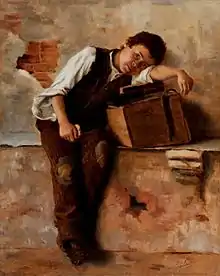
| Italian immigration to Brazil (1876–1920)[57] | |||
|---|---|---|---|
| Region of origin | Number of immigrants | Region of origin | Number of immigrants |
| Veneto (North) | 365,710 | Sicily (South) | 44,390 |
| Campania (South) | 166,080 | Piedmont (North) | 40,336 |
| Calabria (South) | 113,155 | Apulia (South) | 34,833 |
| Lombardy (North) | 105,973 | Marche (Center) | 25,074 |
| Abruzzo-Molise (South) | 93,020 | Lazio (Center) | 15,982 |
| Tuscany (Center) | 81,056 | Umbria (Center) | 11,818 |
| Emilia-Romagna (North) | 59,877 | Liguria (North) | 9,328 |
| Basilicata (South) | 52,888 | Sardinia (South) | 6,113 |
| Total : 1,243,633 | |||
Areas of origin
Most of the Italian immigrants to Brazil came from Northern Italy; however, they were not distributed homogeneously among the extensive Brazilian regions. In the State of São Paulo, the Italian community was more diverse including a large number of people from the South and the Center of Italy.[58] Even today, 42% of the Italians in Brazil came from Northern Italy, 36% from Central Italy regions, and only 22% from Southern Italy. Brazil is the only American country with a large Italian community in which Southern Italian immigrants are a minority.[35]
In the first decades, the vast majority of the immigrants came from the North. Since Southern Brazil received most of the early settlers, the vast majority of its immigrants came from the extreme North of Italy, mainly from Veneto and particularly from the provinces of Vicenza (32%), Belluno (30%) and Treviso (24%).[30] In Rio Grande do Sul, many came from Cremona, Mantua, from parts of Brescia, and also from Bergamo, in the region of Lombardy, close to Veneto. The regions of Trentino and of Friuli-Venezia Giulia also sent many immigrants to the South of Brazil. Of the immigrants in Rio Grande do Sul, 54% came from the Veneto, 33% from Lombardy, 7% from Trentino, 4.5% from Friuli-Venezia Giulia and only 1.5% from other parts of Italy.[59]
From the early 20th century, the agrarian crisis started to affect Southern Italy as well, and many people immigrated to Brazil, mostly to the state of São Paulo, since it needed workers to embrace the coffee plantations. The Italian immigrants in São Paulo came from mostly Veneto, Calabria, Campania.[60]
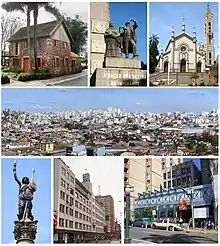
| Italian immigration to Brazil, Argentina, Uruguay, Paraguay[61] | |||
|---|---|---|---|
| Region | Percentage | ||
| North | 53.7% | ||
| South | 32.0% | ||
| Centre | 14.5% | ||
Italian regional origin of Brazil, Argentina, Uruguay, Paraguay immigrants:
| Region | Percentage |
|---|---|
| Veneto | 26.6% |
| Campania | 12.1% |
| Calabria | 8.2% |
| Lombardy | 7.7% |
| Tuscany | 5.9% |
| Friuli-Venezia Giulia | 5.8% |
| Trentino-Alto Adige/Südtirol | 5.3% |
| Emilia-Romagna | 4.3% |
| Basilicata | 3.8% |
| Sicily | 3.2% |
| Piedmont | 2.8% |
| Apulia | 2.5% |
| Marche | 1.8% |
| Molise | 1.8% |
| Lazio | 1.1% |
| Umbria | 0.8% |
| Liguria | 0.7% |
| Sardinia | 0.4% |
| Aosta Valley | 0.2% |
| Main group of Italians immigrants living in São Paulo State (1936)[62] | |||
|---|---|---|---|
| Region | Population | ||
| Veneto | 228,142 | ||
| Campania | 91,960 | ||
| Calabria | 72,686 | ||
| Lombardy | 51,338 | ||
| Tuscany | 47,874 | ||
| Main groups of Italians in some neighborhoods in São Paulo | |||
|---|---|---|---|
| Region | Neighborhood[30][63] | ||
| Calabria | Bixiga | ||
| Campania and Apulia | Brás | ||
| Veneto | Bom Retiro | ||
Italian influences in Brazil
Language
Gina Lombroso, Italian traveler in São Paulo (1908)[64]
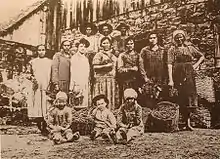
Most Brazilians with Italian ancestry now speak Portuguese as their native language. During the Second World War, the public use of Italian, German, and Japanese was forbidden.[65][66]
Italian dialects have influenced the Portuguese spoken in some areas of Brazil. Italian was so widespread in São Paulo that the Portuguese traveler Sousa Pinto said that he could not speak with cart drivers in Portuguese because they all spoke Italians dialects and gesticulating as Neapolitans.[67]
The Italian influence on Portuguese spoken in São Paulo is no longer as great as before, but the accent of the city's inhabitants still has some traces of the Italian accents common in the beginning of the 20th century like the intonation and such expressions as Belo, Ma vá!, Orra meu! and Tá entendendo?.[68] Other characteristic is the difficulty to speak Portuguese in plural, saying plural words as they were singulars.[69] The lexical influence of Italian on Brazilian Portuguese, however, has remained quite small.
A similar phenomenon occurred in the countryside of Rio Grande do Sul but encompassing almost exclusively those of Italian origin.[59] On the other hand, is a different phenomenon: Talian, which emerged mostly in the northeastern part of the state (Serra Gaúcha). Talian is a variant of the Venetian language with influences from other Italian dialects and Portuguese.[1] In Southern Brazilian rural areas marked by bilingualism, even among the monolingual Portuguese-speaking population, the Italian-influenced accent is fairly typical.
Music
The Italian influence in Brazil affects also music with traditional Italian songs but also with the merging with other Brazilians music styles. One of the main results of the fusion is samba paulista, a samba with strong Italians influence.
Samba paulista was created by Adoniran Barbosa (born João Rubinato), the son of Italians immigrants. His songs translated the life of the Italian neighborhoods in São Paulo and merged São Paulo dialect with samba, which latter made him known as the "people's poet."[70]
One of the main example is samba italiano, which that has a Brazilian rhythm and theme but (mostly) Italian lyrics. Below, the lyrics of this song have the parts in (mangled) Portuguese in bold and the parts in Italian in a normal font:
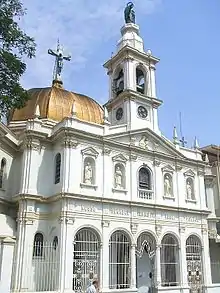
| Original in São Paulo's pidgin
Gioconda, piccina mia,
Piove, piove,
Ti ricordi, Gioconda,
|
Free translation to English Gioconda, my little
It rains, it rains
Do you remember, Gioconda
|
St. Vito Festival

St. Vito Festival is one of the most important Italian festivals in São Paulo and celebrates Saint Vito, a Christian martyr who was killed in June 303 AD who is the patron saint of Polignano a Mare, a city in the Apulia region of Southern Italy. Italian immigrants from Apulia moved in great numbers to the Brás neighborhood of São Paulo in the late 19th century, bringing with them a devotion to Saint Vito. The festival is also a time when the Italian community in São Paulo gathers to party and eat traditional food. Other important Italian celebrations in São Paulo are Our Lady of Casaluce, also in Brás (in May), Our Lady of Achiropita, in Bela Vista (August), and St. Gennaro, in Mooca (September).
Just like Polignano a Mare, Brás eventually had a church devoted to St. Vito. An association was formed and hosted the first festival in June 1919. As São Paulo grew, so did the Italian community and St. Vito Festival. Today, about 6 million of São Paulo's 10,886,518 inhabitants are Italians and descendants (known as "oriundi"), according to statistics provided by Conscre, a São Paulo state council for foreign communities. An estimated 140,000 people were expected to attend the festival in 2008.
Food
Italians brought new recipes and types of food to Brazil and also helped in the development of the cuisine of Brazil. Italian staple dishes like pizza and pasta are very common and popular in Brazil. Pasta is extremely common, either simple unadorned pasta with butter or oil or accompanied by a tomato- or bechamel-based sauce.
Aside from the typical Italian cuisine like pizza, pasta, risotto, panettone, milanesa, polenta, calzone, and ossobuco, Italians helped to create new dishes that today are typically considered Brazilian. Galeto (from the Italian galletto, little rooster), frango com polenta (chicken with fried polenta), Bife à parmegiana (a steak prepared with Parmigiano-Reggiano), Mortadella sandwich (a sandwich made of mortadella sausage, Provolone cheese, sourdough bread, mayonnaise and Dijon mustard), Catupiry cheese, new types of sausage like linguiça Calabresa and linguiça Toscana (literally Calabrian and Tuscan sausage),[72] chocotone (panettone with chocolate chips) and many other recipes were created or influenced by the Italian community.
Other influences
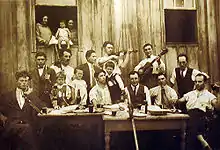
- Use of ciao ("tchau" in Brazilian-Portuguese) as a 'goodbye' salutation (all of Brazil)
- Wine production (in the South)
- A few loanwords (italianisms), such as bisogno, entrevero, esquifoso (schifoso, disgusting), imbróglio, male-male, manjar (mangiare), noccia, noja, nonna, nonnino, and pivete
- Early introduction of more advanced low-scale farming techniques (Minas Gerais, São Paulo and all Southern Brazil)
Education
Italian international schools in Brazil:
- Scuola Italiana Eugenio Montale - São Paulo
- Istituto Italo-Brasiliano Biculturale Fondazione Torino - Belo Horizonte
Current Italian emigration in Brazil
In 2019, 11,663 people with Italian nationality emigrated from Italy to Brazil according to the Italian World Report 2019, totaling 447,067 Italian citizens living in Brazil until 2019.[73]
See also
References
- Enciclopédia de Línguas do Brasil - Línguas de Imigração Européia - Talian (Vêneto Brasileiro). Retrieved 11 September 2008.
- "Personalidades da comunidade italiana recebem o troféu "Loba Romana"". Revista digital "Oriundi". 7 June 2013. Archived from the original on 2 February 2014. Retrieved 25 January 2014.
- "República Italiana". www.itamaraty.gov.br.
- {{cite web|url=https://www.migrantes.it/wp-content/uploads/sites/50/2019/10/Sintesi_RIM2019.pdf |format=PDF |title=Rapporto Italiano Nel Mondo 2019 : Diaspora italiana in cifre |publisher=Web.archive.org |access-date=2019-01-01
- A game of mirrors: the changing face of ethno-racial constructs and language in the Americas. Thomas M. Stephens. University Press of America, 2003. ISBN 0-7618-2638-6, ISBN 978-0-7618-2638-5. Retrieved on 2010-10-14.
- "Italians - History of the Community". Milpovos.prefeitura.sp.gov.br. Archived from the original on 12 January 2009. Retrieved 11 January 2018.
- Cilmar Franceschetto. Espírito Santo, lo stato più veneto del Brasile (in Italian) Archived 2007-08-14 at the Wayback Machine, Retrieved 31 May 2016.
- José Carlos Mattedi. Consulado italiano vai abrir dois escritórios em Vitória para agilizar pedidos de cidadania (in Portuguese) Archived 2011-08-10 at the Wayback Machine
- "Nova Veneza (in Portuguese)". Archived from the original on 19 August 2008.
- IBGE.Censo brasileiro de 1940.
- Simon Schwartzman (1999). "Fora de foco: diversidade e identidades étnicas no Brasil" (in Portuguese). Retrieved 7 January 2016.
- "Italinani nel mondo: Diaspora italiana in cifre" [Italians in the world: Italian diaspora in figures] (PDF). migrantes.it (in Italian). 1 January 1996. p. 2. Archived from the original (PDF) on 27 February 2008. Retrieved 7 January 2016.
- "Veja 15/12/99". abril.com.br.
- "Notizie d'Italia - Cavalcanti é a maior família brasileira". italiaoggi.com.br.
- "Migração - Cidadania Italiana - Dupla Cidadania - Encontro analisa imigração italiana em MG". italiaoggi.com.br.
- Immigrazione Italiana nell’America del Sud (Argentina, Uruguay e Brasile). p. 36.
- Clemente, Elvo.Italianos no Brazil p.231
- Favero, Luigi; Graziano Tassello. Cent'anni di emigrazione italiana (1876–1976). p. 136.
- Constitutional amendment ECR-000.003-1994
- Desiderio, Peron (18 June 2007). "Pollastri confirma que o Parlamento italiano estuda restrições à cidadania por direito de sangue na terceira geração" [Pollastri confirms that the Italian Parliament is considering restrictions on citizenship by right of blood in the third generation]. Insieme (in Portuguese). insieme.com.br. Retrieved 25 April 2017.
- "Roteiro para a obtenção do reconhecimento da cidadania Italiana" [Guideline for recognition of Italian citizenship]. Consulate General of Italy in Sao Paulo (in Portuguese). Archived from the original on 11 October 2007.
- Gabaccia, Donna R.; Ottanelli, Fraser M. (2001). "Introduction". In Donna R. Gabaccia; Fraser M. Ottanelli (eds.). Italian Workers of the World: Labor Migration and the Formation of Multiethnic States. University of Illinois Press. p. 2. ISBN 978-0-252-02659-1.
- Generations. Family Tree plus v.8,5. Software to design genealogical trees. Additional information of groups of immigrants that settled in the US.
- IBGE. Brasil 500 anos - Italianos - Regiões de Origem Archived 30 May 2008 at the Wayback Machine. Retrieved 10 September 2008.
- DEL BOCA, Daniela; VENTURINI, Alessandra. Italian Migration. Working paper in CHILD Centre for Household, Income, Labor and Demographic Economics. 2001 Archived 26 September 2007 at the Wayback Machine. Retrieved 10 September 2008.
- Buckman, Kirk (2004). "VI. Italian Citizenship, Nationality Law and Italic Identities". In Piero Bassetti; Paolo Janni (eds.). Italic Identity in Pluralistic Contexts: Toward the Development of Intercultural Competencies. CRVP. p. 83. ISBN 978-1-56518-208-0.
- IBGE - Instituto Brasileiro de Geografia e Estatística
- IBGE.Brazilian Census of 1940.
- Schwartzman, Simon (November 1999). "Fora de foco: diversidade e identidades étnicas no Brasil" [Out of focus: diversity and ethnic identities in Brazil] (PDF). Novos Estudos (in Portuguese). Brazilian Centre for Analysis and Planning (CEBRAP) (55): 3. Retrieved 25 April 2017.
- Do Outro Lado do Atlântico - Um Século de Imigração Italiana no Brasil, p. 100, at Google Books
- Angelo Trento. Do outro lado do Atlântico: um século de imigração italiana no Brasil, p. 67, at Google Books
- "Imigração italiana por Estados e Regiões do Brasil". Retrieved 2 December 2014.
- Pereira, Liésio. "A capital paulista tem sotaque italiano" (in Portuguese). radiobras.gov.br. Archived from the original on 28 July 2006. Retrieved 10 September 2008.
- "Archived copy" (PDF). Archived from the original (PDF) on 21 March 2012. Retrieved 30 June 2011.CS1 maint: archived copy as title (link)
- "Gli Italiani in Brasile" [The Italians in Brazil] (PDF) (in Italian). consultanazionaleemigrazione.it. October 2003. pp. 11, 19. Archived from the original (PDF) on 12 February 2012. Retrieved 3 October 2010.
- COLLI, Antonello. Italiani in Brasile, 36 milioni di oriundi. L'Italia nel'Mondo Website Archived 3 February 2009 at the Wayback Machine. Retrieved 10 September 2008.
- Italianos no Brasil: "andiamo in 'Merica-", p. 252, at Google Books
- Estados autoritários e totalitários e suas representações, p. 179, at Google Books
- "IMIGRANTES ITALIANOS: Um portal de ajuda na pesquisa da origem dos ancestrais italianos". imigrantesitalianos.com.br.
- Fazer a América: a imigração em massa para a América Latina, p. 318, at Google Books
- Artes plásticas na Semana de 22, p. 76, at Google Books
- Relatório Apresentado pela Comissão de Estatística ao Exmo. Presidente da Província de São Paulo, 1888, p. 24
- "Recenseamento do Brazil. Realizado em 1 de Setembro de 1920. População (5a parte, tomo 2). População do Brazil, por Estados e municipios, segundo o sexo, a nacionalidade, a idade e as profissões". archive.org. Typ da Estatistica. 1930.
- "p.177". Archived from the original on 30 June 2013. Retrieved 30 June 2013.
- Censo Demográfico 1940, pt. XVII, t. 1, SP, p. 103
- "Recenseamento do Brazil. Realizado em 1 de Setembro de 1920. População (1a parte). População do Brazil por Estados, municipios e districtos, segundo o sexo, o estado civil e a nacionalidade". archive.org. Typ da Estatistica. 1926.
- "p. 174". Archived from the original on 30 June 2013. Retrieved 30 June 2013.
- Censo Demográfico 1940, pt. XVII, t. 1, SP, p. 102
- "p. 126". seade.gov.br.
- "Italians in Mato Grosso do Sul". geomundo.com.br. Archived from the original on 14 September 2008. Retrieved 7 October 2008.
- "multiplycontent.com - This website is for sale! - multiplycontent Resources and Information" (PDF). images.paulocel29.multiply.multiplycontent.com. Cite uses generic title (help)
- J.M.Fantinatti (2006). "Pró-Memória de Campinas-SP". pro-memoria-de-campinas-sp.blogspot.com.
- "Sobrenomes Italianos". imigrantesitalianos.com.br.
- Alciate, Silvia. "Na comemoração do Dia Nacional da Republica Italiana, Festa Popular na rua do Consulado da Itália em Belo Horizonte" [In commemoration of the National Day of the Italian Republic, a festival on the street of the Italian Consulate in Belo Horizonte]. Insieme: Revista Italiana Daqui (in Portuguese). Archived from the original on 6 February 2008.
- IBGE - Instituto Brasileiro de Geografia e Estatística. "IBGE - Séries Estatísticas & Séries Históricas - atividade industrial - indústrias extrativa e de transformação - séries históricas e encerradas - inquéritos e Censos industriais - Estabelecimentos industriais nas datas dos Inquéritos Industriais e do Censo 1920 - 1907-1920". ibge.gov.br.
- Bresser-Pereira, Luiz Carlos. "Origens Étnicas e Sociais do Empresário Paulista" [Ethnic and Social Origins of Entrepreneurship in São Paulo] (PDF) (in Portuguese). Archived from the original (PDF) on 3 March 2016. Retrieved 12 August 2015.
- IBGE. "IBGE - Brasil: 500 anos de povoamento - território brasileiro e povoamento - italianos - regiões de origem". ibge.gov.br.
- Seyferth, Giralda. "Histórico da Imigração no Brasil: Italianos" [History of Immigration in Brazil: Italians] (in Portuguese). Dias Marques Advocacia. Archived from the original on 10 October 2004.
- "Italianos: A maior parte veio do Vêneto" [Italians: A major portion came from Veneto] (in Portuguese). riogrande.com.br. Archived from the original on 7 June 2008. Retrieved 10 September 2008.
- MORILA, Aílton Pereira. "Pelos Cantos da Cidade: Música Popular em São Paulo na Passagem do Século XIX ao XX. Fênix – Revista de História e Estudos Culturais; January-February-March 2006; Vol. 3; Ano III; nº 1" (PDF). Fênix: Revista de História e Estudos Culturais (in Portuguese). ISSN 1807-6971. Retrieved 9 September 2008.
- "Immigrazione Italiana nell'America del Sud (Argentina, Uruguay e Brasile)" [Italian Immigration in South America (Argentina, Uruguay and Brazil)] (PDF) (in Italian). immigrazione-altoadige.ne. Archived from the original (PDF) on 21 February 2011.
- Do outro lado do Atlântico: um século de imigração italiana no Brasil at Google Books
- Mérica, Mérica!: italianos no Brasil, p. 111, at Google Books
- "Full text of "Nell' America meridionale (Brasile-Uruguay-Argentina)"". archive.org.
- Thomé, Nilson (2008). "A Nacionalização do Ensino no Contestado, Centro-Oeste de Santa Catarina na Primeira Metade do Século XX" [The Nationalization of Education in the Contested, Center-West of Santa Catarina in the First Half of the 20th Century] (in Portuguese). revistas.udesc.br. pp. 85–86. Retrieved 25 April 2017.
- Bolognini, Carmen Zink; Payer, Maria Onice (June 2005). "Línguas do Brasil - Línguas de Imigrantes" [Languages of Brazil - Languages of Immigrants] (PDF). Ciência e Cultura (in Portuguese). São Paulo: Brazilian Society for the Advancement of Science. 57 (2): 42–46. ISSN 0009-6725. Retrieved 25 April 2017.
- Zink Bolognini, Carmen; de Oliveira, Ênio; Hashiguti, Simone (September 2005). "Línguas estrangeiras no Brasil: História e histórias" [Foreign Languages in Brazil: History and Narratives] (PDF). Language and literacy in focus: Teaching foreign languages (in Portuguese). Institute of Language Studies (IEL), Brazil. Archived from the original (PDF) on 27 March 2012.
- "Domínio LocaWeb". uol.com.br.
- "G1 - Sotaque da Mooca pode virar patrimônio histórico imaterial de SP - notícias em São Paulo". globo.com.
- "Adoniran Barbosa, o Poeta do Povo" [Adoniran Barbosa, the Poet of the People]. globo.com (in Portuguese). Archived from the original on 12 June 2008.
- "Laticínios Catupiry: History". catupiry.com.br. Archived from the original on 9 June 2010.
- "Linguiça calabresa" (in Portuguese). caras.uol.com.br. 13 January 2009. Archived from the original on 1 April 2012.
- {{cite web|url=https://www.migrantes.it/wp-content/uploads/sites/50/2019/10/Sintesi_RIM2019.pdf |format=PDF |title=Rapporto Italiano Nel Mondo 2019 : Diaspora italiana in cifre |publisher=Web.archive.org |accessdate=2019-01-01
Further reading
- Bertonha, João Fábio. Os italianos. Editora Contexto. São Paulo, 2005 ISBN 85-7244-301-0
- Cenni, Franco. Os italianos no Brasil. EDUSP. São Paulo, 2003 ISBN 85-314-0671-4
- Clemente, Elvo (et all). Italianos no Brasil: contribuições na literatura e nas ciências, séculos XIX e XX EDIPUCRS. Porto Alegre, 1999 ISBN 85-7430-046-2
- Franzina, Emilio. Storia dell'emigrazione italiana. Donzelli Editore. Roma, 2002 ISBN 88-7989-719-5
- Favero, Luigi y Tassello, Graziano. Cent'anni di emigrazione italiana (1876–1976). Cser. Roma, 1978
- Trento, Ângelo. Do outro lado do Atlântico. Studio Nobel. São Paulo, 1988 ISBN 85-213-0563-X
External links
- oriundi.net, a site for descendants from Italians in Brazil
